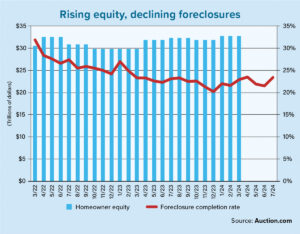Every minute in 2019, 188 million emails, 18.1 million texts and 46.1 million Facebook and WhatsApp messages were sent, according to VisualCapitalist.com. During that same minute, 1 million people log onto Facebook, 87,500 people are sending tweets and 3.8 million people start Google search queries. Why does this matter? Because every interaction provides information that can be gathered and turned into data to track trends and provide insights into predicting people’s behavior.
Although data and machine learning influence marketing, this technology also has a role to play in real estate. Traditionally, mortgage lenders were tied to assessing prospective borrowers and current clients based on their credit score, credit report, income, assets, debts and job history. Property valuations depended on trained appraisers to compare properties.
Big data can now be harnessed to improve lender understanding of clients, to evaluate property, to increase efficiency and to mitigate risk. For mortgage lenders and the originators who work with them, technology offers the opportunity to widen the credit window while making it easier to assess the creditworthiness of consumers with thin credit reports and multiple gig-economy jobs.
For mortgage lenders and the originators who work with them, technology offers the opportunity to widen credit windows.
Information gathered from bank statements, loan files, tax returns, credit reports, credit-card statements and more can be aggregated to predict consumer behavior. Consumers themselves can benefit from a more efficient process, speedier underwriting and the use of analytics that can streamline their online experience.
Of course, one of the most important elements of any real estate transaction is the property itself. Big data has an essential role to play in helping lenders evaluate the underlying assets for their mortgages and determining whether a trans- action should go forward.
Powerful tool
Lenders of all sizes, as well as real estate investors, have long relied on the expertise of appraisers to establish the value of both residential and commercial properties. As machine learning and artificial intelligence have become increasingly accessible to all types of businesses, automated home valuations (AVMs) also have gained popularity.
Among the best-known AVMs are those found on real estate sites such as Zillow and Redfin, but users have often complained about the broad range of estimated values. Typically, these consumer-facing estimates are designed to generate leads for real estate agents and the actual property value may be entirely different.
Lenders, however, have access to more sophisticated AVMs based on an even larger pool of data. These AVMs rely on data-bases with historical information about property sales, tax assessments, mortgage liability records and recent transactions, both within local markets and on a wider scale. Unlike appraisals, which are at least partially subjective and rely on a handful of comparable homes, AVMs are objective and have a comprehensive pool of similar homes.
The accuracy of any valuation, whether done by an appraiser or an automated system, depends on the inputted information. In an automated valuation, the sheer volume of information can offset the instances of dirty data — data with erroneous information — to a small degree.
An appraiser, who has access to only a small amount of local market information, can be more at risk of relying on faulty facts. Appraisals that rely on an individual evaluation of a property, however, have one advantage over a machine: A human looking directly at the condition of the property can have extra insights into things such as the view, the location on the block, and the state of the appliances and systems.
An AVM can be particularly valuable for certain properties, such as when a homeowner is refinancing, or if they are taking out a home equity loan or line of credit. A full appraisal may not be necessary when a lender has already done an evaluation of the property when it was purchased. For purchase applications, an AVM can sometimes be a substitute for a traditional appraisal, particularly if the home is similar to others in the neighborhood. A unique home may require an in-person appraisal for accuracy, although an AVM can even be valuable under these circumstances because the data can encompass far more potentially comparable properties.
One other benefit of an AVM can be speed. At a time when mortgage originators are sometimes overwhelmed with refinance applications or in a hot real estate market, in-person appraisals can take too long to schedule. An accurate AVM can be done more quickly with the help of technology.
Get a FREE subscription to Scotsman Guide Magazine
The Premier Resource for Residential Mortgage Originators
Evolving regulations
Although full appraisals are still required on many real estate transactions, the rules are changing in favor of automated home valuations. The government-sponsored enterprises (GSEs) Fannie Mae and Freddie Mac, for instance, offer appraisal waivers for some purchase and refinance transactions. There are a number of stipulations that must be met to qualify for an AVM through the agencies.
Last year, federal regulators changed the home-value limits for appraisal requirements, a move that was anticipated to impact about 40% of all home sales. Transactions that involve properties of $400,000 or less will no longer require an appraisal. Previously, the threshold for an appraisal exemption was $250,000. It was the first time in 25 years that regulators had increased the limit for requiring an appraisal. Instead of an appraisal, lenders for these properties must obtain an evaluation of the property’s estimated market value.
This new exemption does not apply to loans sold to the GSEs, or those guaranteed by the Federal Housing Administration or U.S. Department of Veterans Affairs, Fannie Mae or Freddie Mac. Many of these mortgages still require an appraisal. The impacted loans are typically portfolio loans held by lenders or sold to investors through the private securitization market. For commercial real estate, no appraisal is needed for properties priced below $500,000.
Relevant solution
Independent mortgage brokers, as well as bank and nonbank originators, need accurate property valuations to successfully underwrite loans. The increasing reliability of AVMs makes them relevant for any real estate evaluation. Evaluating property values with an AVM instead of a standard appraisal depends heavily on accurate data.
AVMs can vary according to the inputs and the volume of information included. This can include such things as county tax records, mortgage records, recent sales history, the age of the home, historical price movements, an analysis of comparable properties, property improvements and physical characteristics of the property, including the square footage and the number of bedrooms and bathrooms.
Mortgage lenders and originators should look for an AVM that collects and analyzes premium property data through the use of multiple sources for property tax, deed, mortgage, foreclosure, environmental risk, natural hazard and neighborhood data. The more data that’s included — and the more accurate that information is — will make the AVM more useful.
This can be a valuable tool for lenders and originators. AVMs for residential or commercial properties can be as accurate — or even more accurate — than a traditional appraisal, provided the data included is precise and thorough. For mortgage professionals, the use of big data to evaluate buyers and properties has been increasing in recent years and is likely to become more common as access to accurate data grows.
Author
-

Rob Barber is CEO of Attom, curator of the nation’s premier property database. After joining the company in 2015, Barber spearheaded the creation of the Attom Data Warehouse. A 25-year veteran in the real estate information-services industry, Barber directs the ongoing product innovation that leverages the company’s data warehouse and data-delivery platforms, which fuel real estate transparency.





